There are many varieties of trees and shrubs that make for excellent bonsai, whether you’re brand new to the art form or a long-time enthusiast. Some work well as indoor bonsai, while others prefer outdoor climates, like the acacia and, in this case, the Celtis bonsai.
The Celtis is a unique, flowering tree that may be either deciduous or evergreen, depending on the variety, growing brightly colored fruit ranging from orange-brown to purple-black. When you go looking for Celtis to bring home, though, you will most likely find the Chinese (or Japanese) Hackberry as an option, which is the most commonly used Celtis for bonsai.
Let’s take a look and see if this unique and attractive tree might be the right choice of bonsai for you.
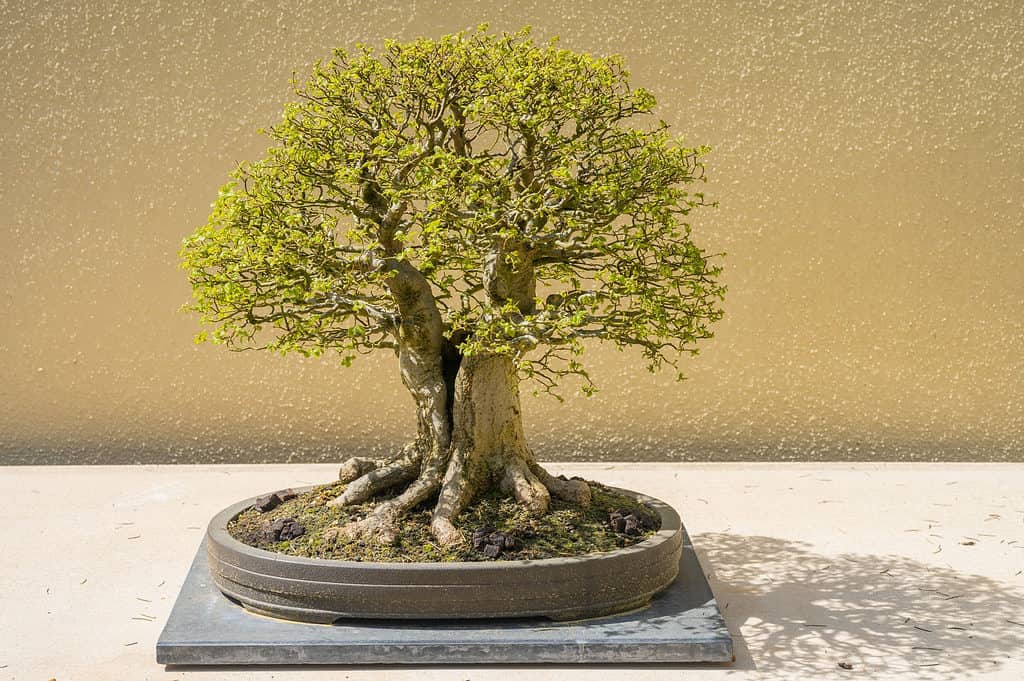
Celtis bonsai, in this case the Chinese Hackberry, is a beautiful option for a distinctive tree style.
©Mariusz S. Jurgielewicz/Shutterstock.com
What Makes Celtis Good for Bonsai?
Celtis make an excellent bonsai tree for numerous reasons, particularly for beginners and casual enthusiasts that won’t have loads of time to devote to the art form.
- Easy to care for
- Fast growing, so excellent for folks learning the art
- Beautiful and intriguing
- Reasonably easy to find
Celtis Classification
Celtis trees and shrubs are part of the Ulmaceae family, which is known as the Zelkova or Elm family. There are at least 70 species within the Celtis genus, with most varieties being deciduous. The coastal varieties, however, are evergreen, such as in Cape Town, South Africa.
Celtis Description
The Celtis tree may either be deciduous with leaves that fall off in autumn or may be an evergreen or a semi-evergreen (meaning the leaves fall but while the new leaves are growing in). The bark is gray and the fruit of the tree is globose and yellow to brown in coloring. The leaves are dark and either ovate or round, depending on the species. The tree blooms in early spring and fruits in early autumn.
Origins and History of Celtis
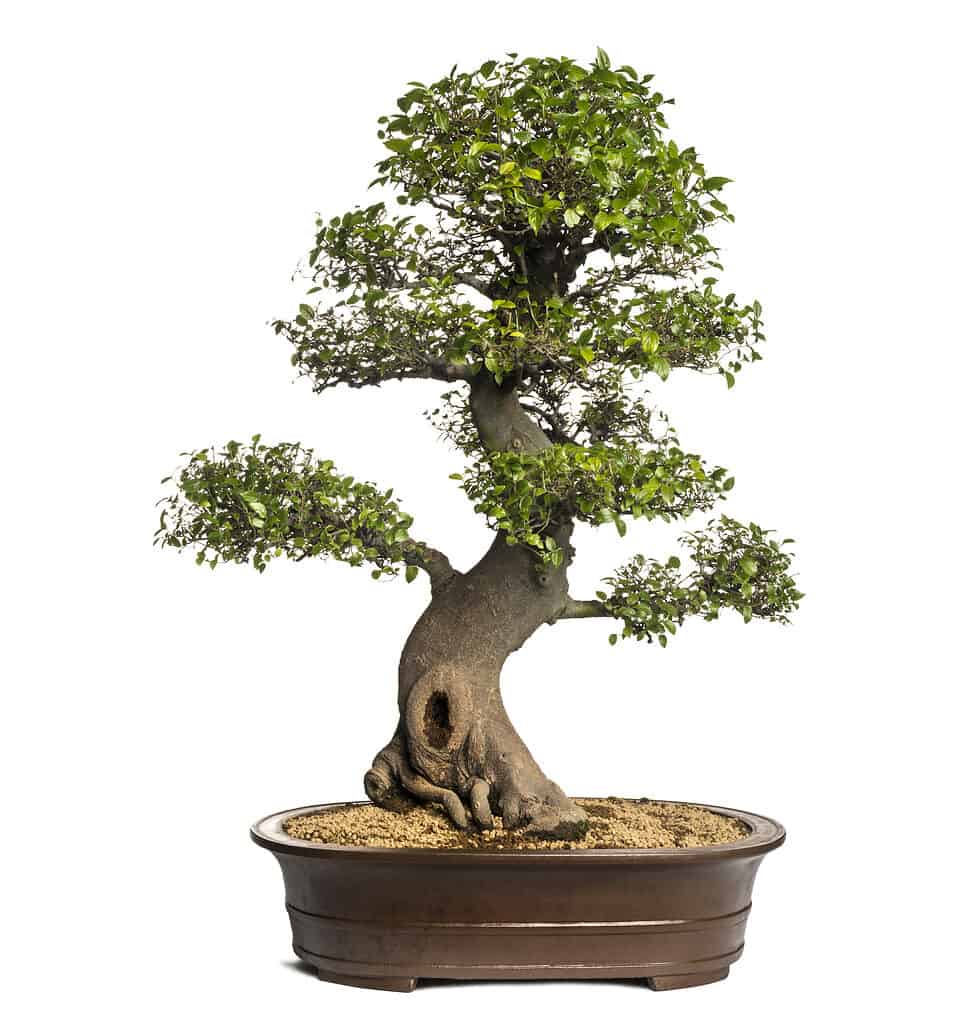
Celtis bonsai isolated on white background
©Eric Isselee/Shutterstock.com
The Celtis tree is native to many altitudes and regions throughout Asia, particularly in Korea, China, Japan, and Korea. It also grows in Africa, North America, and the Mediterranean. The plant is primarily used as an ornamental tree in classical eastern Asian garden design, while in Korea it is used medicinally for menstruation concerns and lung conditions.
The plant has been exported to many other countries, including the USA and Australia. In North America, it has become a naturalized non-invasive species, while in certain parts of Australia, it has been declared a noxious weed. So, it may not be available for the bonsai art in all regions of the world.
Varieties of Celtis
There are many types of Celtis trees, but two primary varieties of Celtis bonsai tree options will be found most commonly: the Celtis africana and the Celtis sinensis. Most often in North America, you’ll find Celtis sinensis available.
Celtis africana
When left to its own devices, the Celtis Africana will grow to between 27 and 45 feet in height, with smooth, gray bark. These are typically coastal plants that are classed as evergreen or semi-evergreen. The flowers are small and yellow and bloom in early to mid-autumn months. They also have small, yellow to brown fruit that grows on long stalks.
Celtis Sinensis
The Celtis sinensis looks similar to Celtis Africana but in the wild it grows between 36 and 45 feet in height. The leaves are glossy and dark, and not as pointed in shape as the Africana leaves. One variety within this has round and orange leaves. This is the species known as Chinese Hackberry.
Additional Varieties
Other Celtis varieties you may find include the following:
- Celtis australus – known as Southern Nettle Tree, from the Mediterranean and southwest Asia, with black fruit
- Celtis gomphyl/a – known as Bastard White Stinkwood, growing from Transkei Coast to North Natal, with yellow fruit
- Celtis mildbraedii – known as Natal White Stinkwood, growing in northern Natal, with red fruit
- Celtis occidentalis – known as the Nettle tree in North America, with orange fruit that turns purple
- Celtis koriensis – which grows in eastern Asia, with orange fruit
- Celtis orientalus – known as Pigeonwood, growing on the Natal coast and Transvaal, with purple to black fruit
How to Grow Celtis as Bonsai
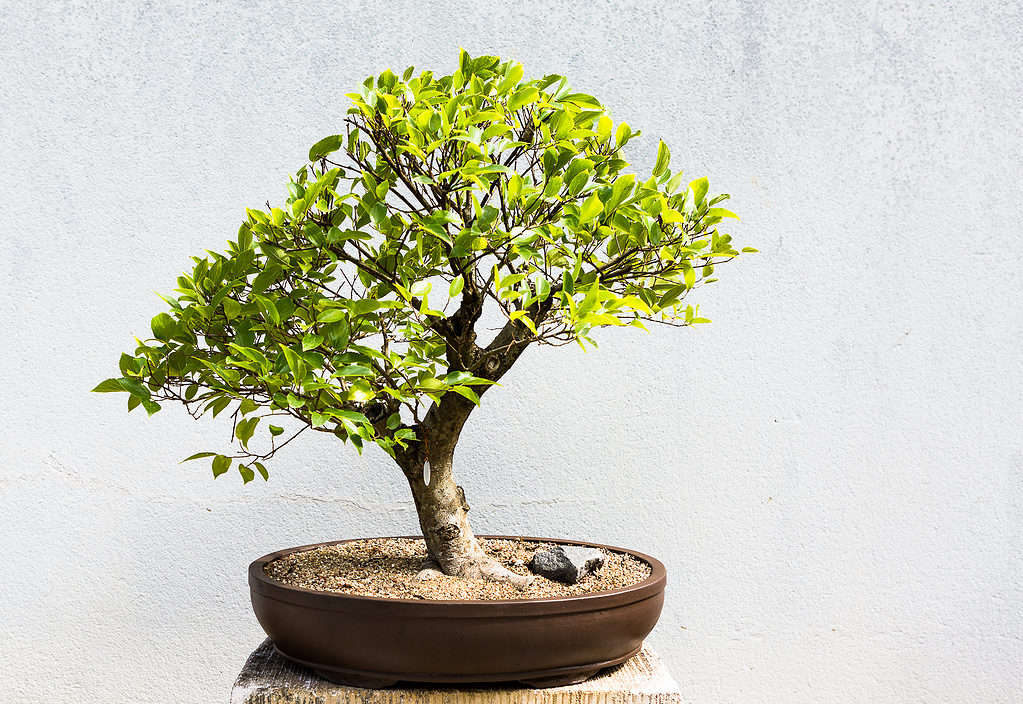
Celtis bonsai look lovely year-round, whether deciduous or evergreen.
©Will Rodrigues/Shutterstock.com
Soil Needs
The main thing that Celtis bonsai requires in regard to soil is that the soil is well-draining. They do fine in either acidic or base soils. They do best in pumice laced soils, though Akadama works as needed. The soil should not be organic, however, but have some organic grit mixed in.
Planting Location
The Celtis bonsai adores sunshine, so it should always be placed somewhere that it receives plenty of natural or enhanced growing light. That is, when outdoors in cool to warm months, they should have direct sunlight for much of the day. In the hottest months, they require a location with partial shade to avoid the plant drying out or burning. The tree will need to be brought indoors in winter months and provided with warm enough temperatures and plentiful light.
Lighting
These trees absolutely adore sunlight and so they need plenty of it year-round. In warmer months when natural lighting is plentiful, they should be placed in direct sunlight on warm to moderately hot days, but they should be in partial shade if temperatures reach over about 80 degrees F. Be sure to water them plenty in sunny months. And when they are brought indoors in wintertime, provide them with hefty growing lights.
Temperature
Celtis bonsai are fairly hardy trees but they need frost protection. If temperatures drop below 23 degrees F in your area, be sure to bring your Celtis indoors or place it in a cold greenhouse, unheated garage, or similar to avoid the plant being harmed by cold temperatures.
Watering
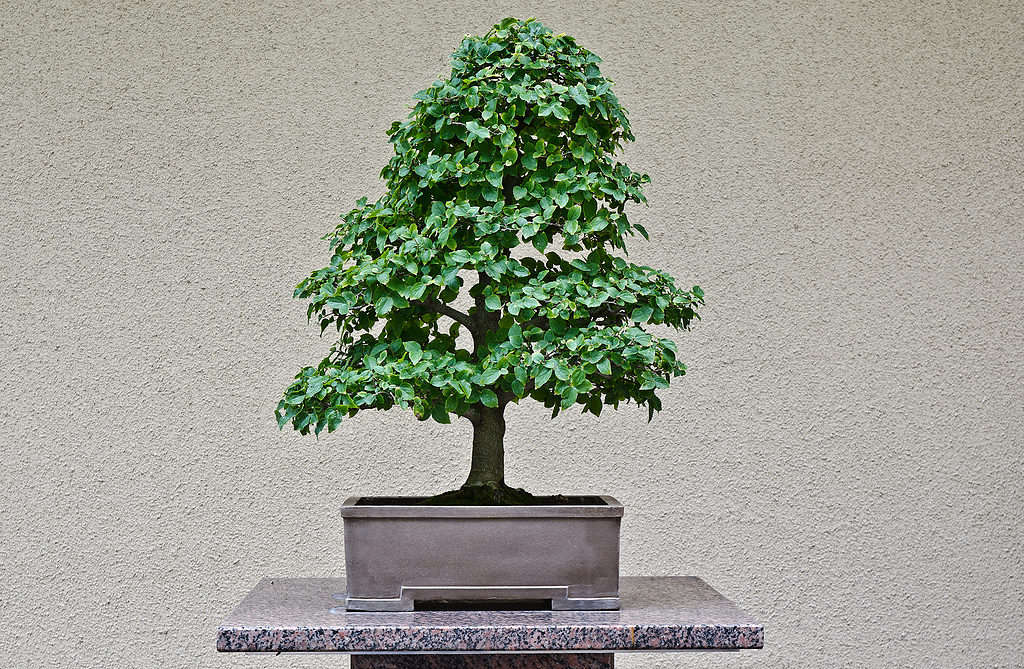
Most commonly, they are shaped into formal or upright styles.
©Marc Bruxelle/Shutterstock.com
The Celtis thrives on loads of sunshine, which also means it needs loads of water. During growing season, they should be watered daily, with foliage misting during the hottest days of the season. As temperatures drop, lower the frequency of watering and check the soil with a moisture meter to ensure you don’t over water the tree. As winter kicks in, lower the watering even more to prevent drowning the plant in its dormant season.
Feeding
Celtis bonsai require frequent feedings since they are fast growers. Use organic fertilizers to provide plenty of nutrients for the trees, feeding the Celtis bonsai approximately every two weeks from late summer into mid-autumn months. As the season slows down, make the feedings less frequent, to about once monthly. Then, when spring, increase feedings again to every other week, until buds start to appear. Begin feeding weekly at this point and keep that weekly feeding going for about 4 to 5 weeks before returning to the bi-monthly feedings.
During growing season, avoid nitrogen-rich fertilizers to avoid over production of leaves and to help the tree save starch for the following growing season.
Pruning, Shaping, and Wiring
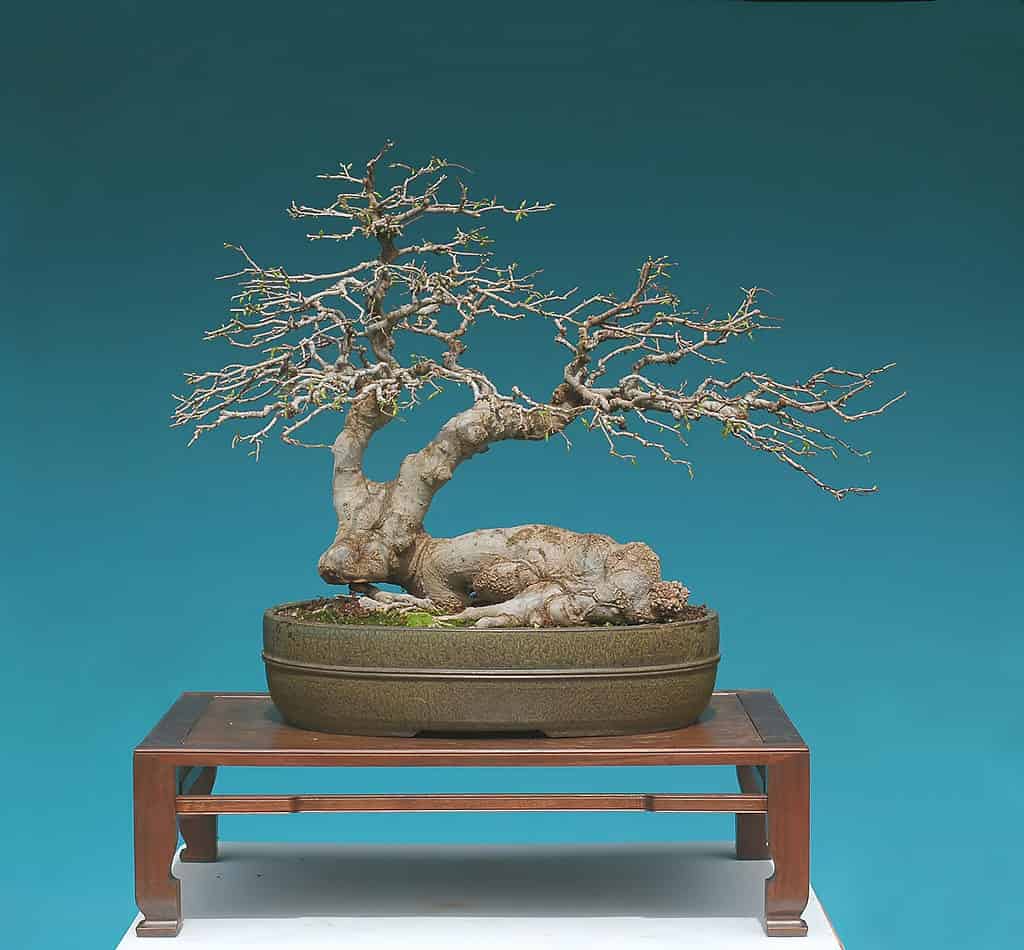
The tree’s fast-growing qualities and ease of manipulation allow it to be grow in unique shapes like this deer form.
©Walter Pall/Shutterstock.com
Typically, Celtis bonsai are trained in upright or formal styles. This means that the most common shapes and styles include:
- Informal upright
- Slanting
- Cascade
- Semi-cascade
- Twin trunk
- Clump
- Straight line
- Sinuous
- Root over rock
They are adaptable to other styles as well, including forest and broom styles. The flexible wood of the Celtis trees make them excellent for experimentation for beginners and well-seasoned bonsai enthusiasts alike.
To train, use aluminum wire to shape the tree in spring to early summer or early autumn. Be careful while wiring, though, as the bark may be damaged. If there is a wound created, be sure to use wound paste immediately and wait for its healing before attempting to wire again. And specifically avoid wiring during winter months as the wood is far more brittle at this time of year and more likely to be broken or damaged during training.
Prune the Celtis during the growing season, pinching new buds to slow down growth. And if you’re planning to propagate, retrieve your cuttings during the first month of summer. Be sure to leave a large enough stump when trimming to encourage proper growth.
Re-potting
Celtis bonsai are fast growers, so they need fairly frequent re-potting. Younger bonsai need to be re-potted every year in early spring months. More established Celtis bonsai generally require re-potting every 2 to 3 years instead. This should also be done in springtime.
When you re-pot the Celtis bonsai, be sure to use properly draining planting medium, such as pumice-laced or Akadama soils. Avoid organic soils, however, as these may cause some issues.
Common Problems of Celtis as Bonsai
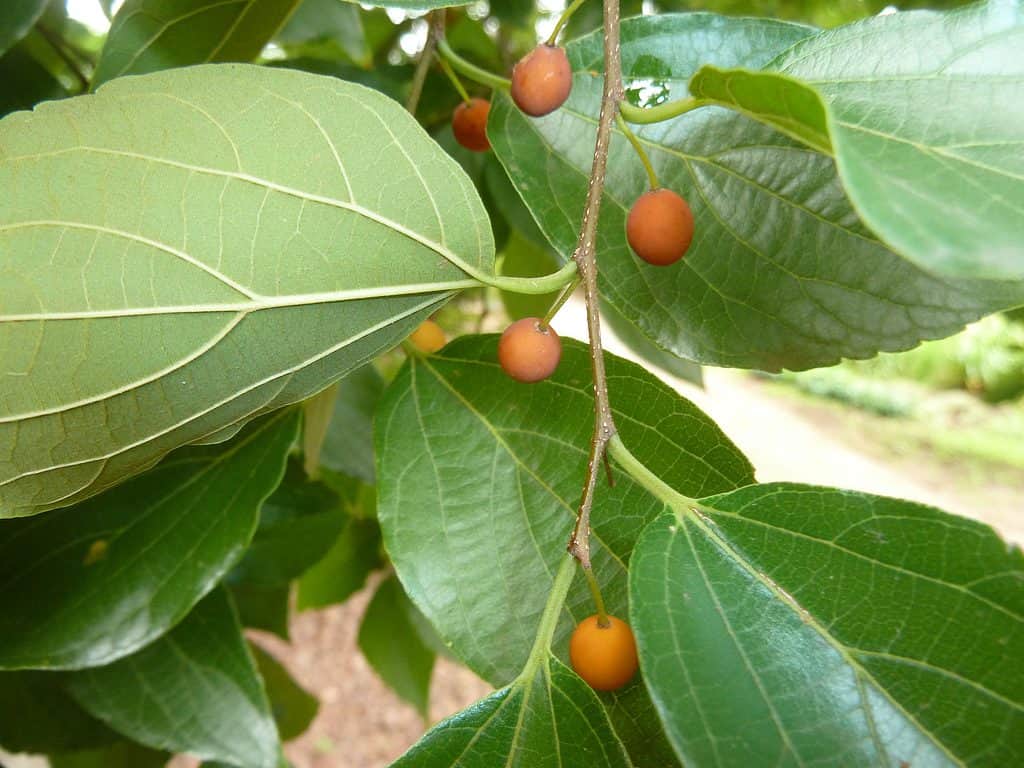
The Celtis fruit comes in a variety of colors.
©JMK, CC BY-SA 3.0, via Wikimedia Commons – Original / License
There are a few common issues with Celtis bonsai.
Over Watering/Root Rot
One of the biggest challenges most folks face with Celtis bonsai is the issue of over watering them. It’s very easy to do for various reasons, including improperly draining soil, over-zealous enthusiasm from beginners, or the simple lack of understanding of how much water they need. This may result in root rot, waterlogging (i.e., basically drowning the plant), or mildew, mold, and similar issues.
To help counter this issue, it’s recommended you invest in a moisture meter and check the soil as directed to ensure the bonsai is receiving enough but not too much water. And if you find the soil is waterlogged and can’t seem to recover, consider repotting with fresh, slightly moist soil.
Red Spiders and Caterpillars
Another potential issue for Celtis bonsai may be red spiders or caterpillars. Typically, these pests invade when the tree doesn’t have proper air circulation or is too dry.
To combat these pests (and other insect infestations), use a gentle, organic pesticide soap or spray, following the directions carefully. Then, once the insects are dead, remove them by hand, wearing gloves, and gently rub the branches and leaves down with rubbing alcohol. Now, move the bonsai’s location to somewhere that will combat the issues of dry air and poor circulation.
How to Propagate Celtis Bonsai Trees
Celtis bonsai are easy to propagate from seeds or cuttings, whichever you’re more comfortable doing.
Growing Celtis from Seeds
If you’re planning to start your Celtis bonsai from seeds, prepare and grow them:
- Find a cool location where you can keep the seeds for 3 months. This could be a basement that’s usually chilly, a cold greenhouse, an unheated garage in winter, or a refrigerator that isn’t “too cold” (i.e., doesn’t form ice on your food).
- Plant the seeds into sand and place them in the cool location for 3 months.
- Sow the seeds in springtime, in well-draining bonsai soil.
- When the seeds begin to sprout, separate them into the bonsai pots and care properly for the seedlings as you would the established tree.
Growing Celtis from Cuttings
Cuttings are another easy way to develop your Celtis bonsai.
- Take cuttings from lignified twigs in early summer.
- Dip the cut end(s) into growth hormone and plant into commercial bonsai growing medium.
- Provide proper light, warmth, water, and air flow as described above, keeping the cuttings moist but not waterlogged.
- When the cuttings have sprouted roots, replant into proper bonsai pot(s) and grow as normal.
Celtis Bonsai FAQs
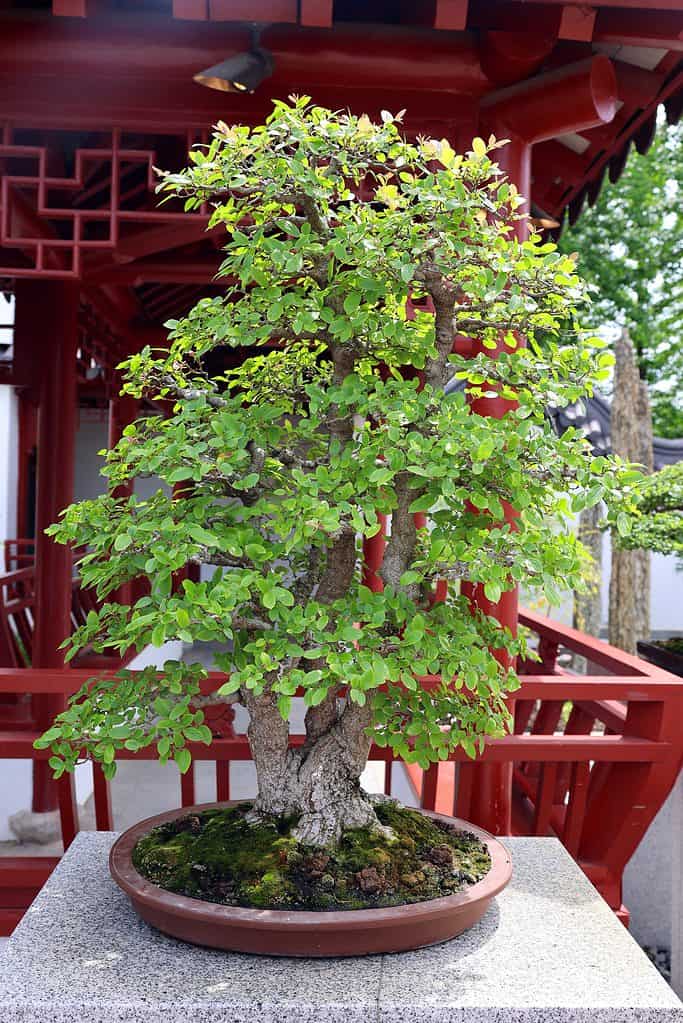
Celtis bonsai on outdoor stand
©meunierd/Shutterstock.com
Celtis bonsai care may leave you with a few questions. Hopefully these FAQs will answer them for you.
Can I keep my Celtis bonsai indoors?
Technically, you may grow your Celtis bonsai indoors, but it will likely be quite challenging to give the plant its full needs for thriving. Indoor bonsais largely suffer due to enough direct, warm sunlight, air circulation, and exposure to problematic indoor issues.
If you do plan to keep your Celtis bonsai indoors, add grow lamps and keep the tree away from air vents, air conditioners, heater vents, and doors leading to the outdoors. These precautions will help prevent the tree from problematic exposures. You’ll also likely want to add a fan to the space to help circulate the air properly and provide an open window as often as possible for fresh, clean air to enter the Celtis bonsai tree’s space.
How long does it take Celtis sinensis to reach maturity?
Hackberry bonsai, or Celtis sinensis trees are fast growers, meaning they won’t take as long as many species often used in the bonsai art (think Chinese elm). They will often gain great size boosts in a single year and will reach maturity within just a few years (three to four). Because of this, however, they require frequent trimmings and root pruning to keep them in bonsai form.
What should I look for when purchasing an established Celtis bonsai?
When you’re ready to purchase a Celtis for bonsai creation, look for an established or young tree that does not have fine twigs. These fine twigs will wind up dying back fairly quickly, leaving a large gap in the growth of the tree.
Instead, look for a Celtis that looks a little rugged or unkempt. Make sure it is young and small enough to suit your bonsai pot, though. Bring it home and gently begin your own trimming and shaping to develop your Celtis bonsai.
Or, ideally, find a bonsai dealer who can help you find the right established Celtis or young Celtis to bring home instead.
Up Next:
Thank you for reading! Have some feedback for us? Contact the AZ Animals editorial team.








